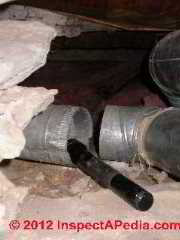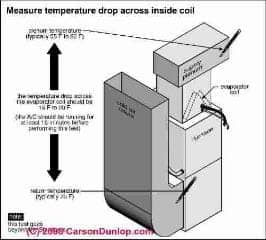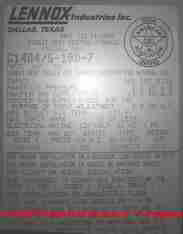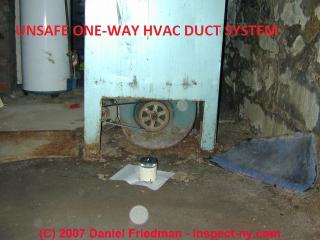What Should The Air Temp Coming Out Of Ceiling Register Be For Heat
 Warm Air Heat Temperatures & Supply Air Temperature Improvement
Warm Air Heat Temperatures & Supply Air Temperature Improvement
Right weak or absurd air from heating registers
- POST a QUESTION or Comment near repairing warm air heating systems that accident as well-cool
InspectAPedia tolerates no conflicts of interest. We take no human relationship with advertisers, products, or services discussed at this website.
Heating furnace supply air temperatures, flows, & improvements.
This article gives typical heating furnace air temperatures measured at different locations.
This article also describes steps to take in finding and fixing the causes of likewise-cool air coming from warm air furnace heating supply registers.
Warming up the air supply coming from your heating system may be as simple equally re-connecting a loose or disconnected return air duct that is drawing too much cool air from the wrong place in your building.
Nosotros as well provide an Commodity INDEX for this topic, or y'all tin endeavor the page top or bottom SEARCH BOX as a quick way to discover information you lot need.
Warm Air Supply Temperature Numbers, Measurements, Improvements
 Question: what is the usual supply air temperature in forced air heating systems?
Question: what is the usual supply air temperature in forced air heating systems?
2018/01/27 Rick said:
What should the temp be at the vent in the room with the stat be at the end of the run, simply earlier the fan shuts off.
This question and answer were posted originally at FURNACE OPERATION DETAILS
Reply: typical supply air temperature for forced air heating: Furnace Temperature Rising or TR
Rick
Here nosotros requite basic furnace supply air temperatures but keep in mind that there is non a single "right" or "exact" number for the situation you depict, since the length of vents, insulation, leaks and many other factors will affect supply air temperature and velocity at various supply registers.
Bottom line: the supply air temperature at a room supply register is typically 100°F-110°F.
Measured at the furnace the supply air temperature typically ranges forty-seventy °F above the return air temperature.
A furnace information tag will ordinarily give a maximum outlet air temperture (typically effectually 170°F) also as a temperature rise (typically xl-lxx°F).
Watch out: if the supply air temperature at your furnace exceeds the upper limit of temperature ascension given on the heater's data tag, inspection and repair are needed since a besides-hot furnace heat exchanger can be damaged, might crack, and could leak dangerous combustion gases or carbon monoxide into the building's supply air. Such a organization would be unsafe.
Where & How is Heating Furnace Air Temperature Rise or Rise Range Documented & Measured?
 Shown: a Lennox furnace data tag giving maxium air temperature and temperature rise. [Click to enlarge any image]
Shown: a Lennox furnace data tag giving maxium air temperature and temperature rise. [Click to enlarge any image]
Typically a service tech looks at the temperature rise betwixt the temperature of the return air and the supply air measured AT THE FURNACE at installation.
The rated furnace output air temperature is expressed as ascension above the render air temperature and is given as a range, commonly 30°F between a high and low temperature. This data is found on your heater'south data tag. In that location you will find a statement such every bit
Supply air temperature rise xxx-threescore °F or 40-70 °F. On a residential heating furnace you volition probably never detect a data tag giving a temperature rise of more than than 45-75 °F .
Go on in mind this is the temperature degree rising measured by comparison incoming return air temperature to approachable supply air temperature at the furnace air handler - well actually almost 2 meters downstream from the bodily heat exchanger.
Nosotros don't mensurate right at the heat exchanger because rut radiated off of the metallic surfaces of the heat exchanger itself would requite a falsely high "air temperature" reading.
This temperature is measured after the furnace has reached its normal operating temperature.
Fan speed and of course blockages in air-flow (such equally a dirty air filter) will affect the bodily temperature ascension you find.
Typical Furnace Fan Limit Switch Control Temperatures
Building temperatures, that is to say the return air temperature at the furnace, will of course affect the actual temperature you will measure coming out of the air handler or at a warm air supply register in heated space.
FAN LIMIT Command SETTINGS gives is the basic operating temperatures measured at the air handler / furnace heat exchanger.
Factory settings at the fan limit switch typically volition be equally follows
ane. FAN ON: not let the fan plow on until temperature reaches xx°F above the FAN OFF - that'south typically around 130°F
two. FAN OFF: the low off number is typically ninety°F
three. FAN LIMIT OFF: the high limit is typically mill set at 200°F - a prophylactic level to avoid overheating
Air Temperatures Measured at Supply Registers
Measured downstream from the air handler, in the ductwork or at an individual room air supply register, the temperature will thus always be lower than right at the oestrus exchanger / supply plenum.
A typical supply air temperature measured at a supply register of a forced air heating organization is effectually 110 degF.
Heating Furnace Runs just Delivers Air that is Cool or Not Warm Plenty
viii Feb 2015 brianbe said:
I have a Rheem/Rudd model UGDG05EAUER up catamenia LP gas fired warm air furnace rated at 50,000 BTU's and 80% efficient. I am not an HVAC guy, just I take ever felt that the output temperature of the furnace was also low. I started pouring over the transmission and did some enquiry on the cyberspace.
[Click to overstate any epitome]
Sketch at left illustrating where to measure temperature drop across a cooling or heating curl was provided courtesy of Carson Dunlop Associates.
I started with checking the heat rise. The furnace is rated for a twenty - 55 caste F rise. I initially measured a supply temperature of ~99 degrees F and a return temperature of ~57 degrees F.
I used a CFM calculation I found on line. I used ane.08 x the 41 degree F rise measured and divided the output BTU's of 42,000 by the previous result of 41 arriving at a CFM rating of ~948.
According to the data charts for this furnace, a speed setting of medium high would give me a CFM of ~900.
I changed the taps and checked the rise once more. At that place was no appreciable difference. I then dropped the heating speed to low and measured again.
Now, the supply temp was ~110 degrees F and the return remained at 57. The furnace is rated for a rise of 25 - 55 degrees F.
With the heat ascent now at 52 I was still in the rated heat ascent for this furnace. I have read that the typical supply temperature of this blazon of furnace is `110 - 135 degrees F.
The maximum supply temperature rating for this furnace is 155 degrees F. How can I increase the supply temperature of the furnace while staying within the rated temperature rising of 25 - 55 degrees F?
I was going to check the gas supply force per unit area before and after the furnace regulator next. The furnace is in an enclosed crawl space that is at ~45 degrees F. The ducts are not insulated. Your aid would greatly exist appreciated.
I am measuring temperatures in the ducts every bit the air leaves (supply) and as the air returns (return) to the furnace. I know that I need to insulate the ducts.
Reply: things to check when air temperatures are besides depression at or leaving the warm air furnace supply plenum
 Brian
Brian
Regarding "How tin can I increase the supply temperature of the furnace while staying within the rated temperature ascent of 25 - 55 degrees F?"
I am guessing you lot mean the supply air at the registers in the occupied infinite is too absurd. Information technology would brand sense to insulate your heating ducts.
Cheers for the clarification.
If air leaving the supply plenum is too cold then I would look for:
- A dingy and partially blocked heat exchanger in the furnace - air is not being adequately warmed as it passes through the heat exchanger.
- Wrong fan speed (too high): air flow rate exceeds the CFM design rate for the furnace in heating manner.
- Improper burner adjustment or flame too small (rare but possible; before measuring or messing with pressure - which is dangerous - just look at the flame to run across if it looks normal or weak).
Obviously if at that place were *no* flame at the gas burner so we'd await for an out-of-fuel problem, ability off, thermostat not calling for oestrus, a bad thermocouple, or a bad flame igniter (on some models this is referred to as a "hot surface igniter).
Run into NO Estrus - FURNACE
- Excessive introduction of outdoor or make-up air

- Improper return air ducting, not recirculating edifice air but rather always taking "new" supply air from a space that is not receiving heated air (illustrated by my ugly onetime furnace photo at above left and by the open un insulated crawlspace ducts in my photo at left).
Return duct leak openings where return ducts run from the occupied space through unoccupied space such equally a cold cranium or clamber space tin give the same consequence.
Run across Return AIR REGISTERS & DUCTS
and run across RETURN DUCT AIR LEAKS
For example I've seen horrible furnace installations that were basically "one-way" heating systems: common cold air from a crawl space was the only supply air for the building;
Cold clamber space air was sent through the furnace to be heated and and then blown (forth with grit and mold) into the occupied space. There were no return ducts from the heated infinite back to the furnace.
Run into DUCT SYSTEM Pattern SIZE & DEFECTS
- Check for warm air stratification near the ceiling - details are
at WARM AIR STRATIFICATION INDOORS
Reader Comments & Q&A
Can I use a indoor thermometer to check heat temp. at register
here'due south 2 photos
Epitome LOST by older version of Clark Van Oyen's useful Comments code - now fixed. Please re-postal service the image if you tin. Distressing. Modernistic.
IMAGE LOST past older version of Clark Van Oyen's useful Comments code - now fixed. Delight re-post the image if you tin can. Sorry. Mod.
our upflow gas furnace has a metal plate that slides in and between where the furnace and ductwork encounter. Above it somebody wrote "dampner install for spring." my question is, does that mean nosotros remove the metal sheet during wintertime for use.
@Josh Mabrey,
Information technology'south probably just a duct that is closer to the evap curlicue
Josh,
While I agree that a smaller duct diameter will perhaps cause some backpressure and tedious down the delivery of warm air at that duct end, I don't retrieve the modify in duct diameter would be the full explanation for cooler output from i HVAC heating supply register. I'd be looking for duct leaks or a longer duct run or missing duct insulation.
Hello we have one flooring register that blows quite a bit cooler than the others. The only difference is that at the end the duct switches from eight" downward to half-dozen". At that size it turns into the floor register. Could that reduction or the elbow plough or a smaller floor register size exist the crusade of the heat loss? Thank you
...
Go on reading at AIR Catamenia Comeback, HVAC or select a topic from the closely-related articles beneath, or see the consummate ARTICLE Alphabetize.
Or meet
FURNACE OPERATING TEMPERATURES
WARM AIR STRATIFICATION INDOORS
Suggested commendation for this web folio
WARM AIR SUPPLY TEMPERATURE & IMPROVEMENT at InspectApedia.com - online encyclopedia of building & environmental inspection, testing, diagnosis, repair, & problem prevention advice.
Or meet this
Index to RELATED Manufactures: Article Index to HVAC DUCT SYSTEMS
Or employ the SEARCH BOX found below to Inquire a Question or Search InspectApedia
...
Ask a Question or Search InspectApedia
Try the search box merely below, or if you prefer, mail service a question or comment in the Comments box below and we will respond promptly.
Search the InspectApedia website
Note: appearance of your Comment below may be delayed: if your comment contains an image, web link, or text that looks to the software as if it might be a web link, your posting will appear afterward it has been approved past a moderator. Apologies for the delay. Our Comment Box is provided past Countable Web Productions countable.ca
Technical Reviewers & References
Click to Evidence or Hide Citations & References
Publisher InspectApedia.com - Daniel Friedman
What Should The Air Temp Coming Out Of Ceiling Register Be For Heat,
Source: https://inspectapedia.com/heat/Warm_Air_Supply.php
Posted by: kaiseradioncy.blogspot.com


0 Response to "What Should The Air Temp Coming Out Of Ceiling Register Be For Heat"
Post a Comment